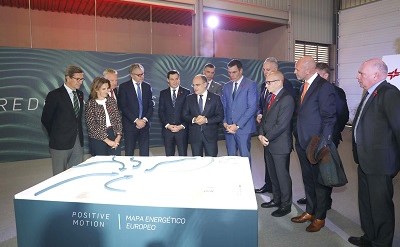- Cepsa will generate 10,000 jobs including direct, indirect, and induced to start up two new plants with total capacity of 2 GW producing up to 300,000 tons of green hydrogen at two new plants in Campo de Gibraltar (Cádiz) and Palos de la Frontera (Huelva)
- The Andalusian Green Hydrogen Valley will help decarbonize industry and heavy land, air, and maritime transport, reducing CO2 emissions by six million tons
- The project, presented today at an event attended by Spanish government officials and Cepsa’s CEO, among other authorities, will strengthen Spain's ambition to lead the energy transition and guarantee an independent energy supply for Europe
- Spanish Prime Minister Pedro Sanchez said: "This investment will help Spain achieve its goal to become an energy exporting country, with the first European green hydrogen corridor between the Campo de Gibraltar and the Dutch Port of Rotterdam. Andalusia has everything it takes to become one of the most competitive regions in the world for hydrogen production.”
- Juan Manuel Moreno Bonilla, President of the Regional Government of Andalusia said: “We are talking about the great energy source of the future, which can decarbonize industry, mobility and households. Andalusia has the position and strength to lead in the generation and export of green hydrogen, and public-private collaboration can strengthen our position in the production of this clean energy vector. That is why we are setting up an Andalusian Green Hydrogen Alliance in which the Administration and all interested parties will participate."
- Cepsa CEO Maarten Wetselaar said: “The Andalusian Green Hydrogen Valley is a groundbreaking project whose 2 GW capacity is 10 times bigger than the largest under construction in Europe today. The project produces green hydrogen at scale that can decarbonize industry, aviation, and heavy road and maritime transport in Europe for Europe.”
- Cepsa has also signed an agreement with the Port of Rotterdam to create the first green hydrogen corridor between southern and northern Europe, allowing the export of green ammonia and methanol
- This is the biggest milestone Cepsa has achieved thus far as part of the development of its Positive Motion strategy and represents 50% of the green hydrogen production planned by the Government for the whole of Spain by 2030
Cepsa, the leading company in Andalusia by sales volume, will invest more than 3 billion euros to establish the Andalusian Green Hydrogen Valley, creating the largest green hydrogen hub in Europe in southern Spain. The project, part of Cepsa’s 2030 strategy Positive Motion, will contribute to Europe's energy security and independence, in line with the objectives of the European Union's REPowerEU strategy. The investment is the biggest milestone to date of Cepsa's Positive Motion energy transition plan to lead sustainable mobility and the production of green hydrogen and advanced biofuels in Spain and Portugal this decade.
The company will build two plants with a total capacity of 2 GW to produce green hydrogen. The plants, with 1 GW of capacity each, will be located in Palos de la Frontera (Huelva) next to Cepsa’s La Rábida Energy Park and at the company’s San Roque Energy Park in Cádiz. The Huelva plant will start up in 2026, reaching full capacity in 2028, while the Cádiz facility will be operational in 2027. Cepsa is already working on the engineering and administrative processing of the project.
To generate the renewable electricity needed to feed production of green hydrogen, Cepsa will develop a 3GW portfolio of wind and solar energy projects with an additional 2 billion euro investment. The company will also collaborate with other renewable energy producers in Andalusia and the rest of Spain to promote the integration of these new plants into the electricity system.
During the presentation of this hub, held this morning at the San Roque Energy Park, Spanish Prime Minister Pedro Sanchez said: “This investment will help Spain achieve its goal to become an energy exporting country, with the first European green hydrogen corridor between the Campo de Gibraltar and the Dutch Port of Rotterdam. Andalusia has everything it takes to become one of the most competitive regions in the world for hydrogen production.”
Juan Manuel Moreno Bonilla, President of the Regional Government of Andalusia, noted that: “We are talking about the great energy source of the future, which can decarbonize industry, mobility, and households. Andalusia has the position and strength to lead in the generation and export of green hydrogen, and public-private collaboration can strengthen our position in the production of this clean energy vector. That is why we are setting up an Andalusian Green Hydrogen Alliance in which the Administration and all interested parties will participate."





